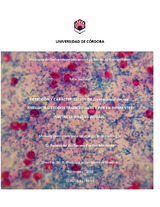Mostrar el registro sencillo del ítem
Detección y caracterización de Crytosporidium spp. mediante métodos tradicionales y PCR en diferentes matrices (heces y aguas)
| dc.contributor.advisor | Martínez-Moreno, Francisco Javier | |
| dc.contributor.author | Fredes Martínez, Fernando Guillermo | |
| dc.date.accessioned | 2016-02-11T09:09:28Z | |
| dc.date.available | 2016-02-11T09:09:28Z | |
| dc.date.issued | 2016 | |
| dc.identifier.uri | http://hdl.handle.net/10396/13240 | |
| dc.description.abstract | Cryptosporidium spp. es un importante parásito protozoario, mundialmente distribuido, que causa enfermedad digestiva en diferentes especies animales, especialmente a terneros menores de 30 días de edad, incluido el humano. Los ooquistes excretados por las heces, que son inmediatamente infectantes y resistentes, contaminan aguas y suelos, constituyendo una amenaza para la salud pública. Debido al escaso número de ooquistes presentes en el ambiente y su reducida dosis infectante se hacen necesarios métodos rápidos y sensibles para su detección en muestras animales y ambientales. Por lo anterior el objetivo de este estudio fue contribuir al conocimiento del diagnóstico de laboratorio tanto microscópico como molecular de Cryptosporidium spp. en muestras de heces diarreicas de terneros y de agua inoculada con el agente, mediante la implementación y estandarización de protocolos microscópicos tradicionales y un ensayo de Reacción en Cadena de la Polimerasa (PCR) género-específico. Para lo anterior, se utilizaron y analizaron 205 muestras fecales diarreicas de terneros, comparando la eficiencia de dos métodos de tinción microscópicas para el diagnóstico del parásito, el de Auremina (AU) y el de Ziehl-Neelsen modificado (ZN). Por primera vez en Chile se usó una prueba inmunocromatografica (CR) y una molecular (PCR) para confirmar la observación microscópica de los ooquistes de Cryptosporidium spp. en la muestras fecales de bovinos estudiadas. De las 205 muestras fecales, se detectaron 115 muestras positivas con AU (56,1%) y 102 con ZN (49,8%), resultado que mostró diferencias significativas (p ≤0,05), al ser AU más sensible. Por otro lado, la concordancia entre los ambos métodos fue casi perfecta (valor kappa de 0,83). El método CR y la realización de una PCR especie específica, también permitieron determinar la identidad de la especie del parásito detectado, como Cryptosporidium parvum. Esta última prueba, realizado en unas pocas muestras tomadas al azar. Así también, de las 102/205 muestras positivas a ZN, se seleccionaron al azar 58 para confirmar los diagnósticos mediante CR y todas resultaron también positivas. Diez muestras fecales ZN negativas, también fueron confirmadas como negativas mediante CR. La PCR género específica desarrollada, confirmó 37 de la 58 ZN positivas (64%) y dio negativa al 100% de las diez muestras CR negativas. La técnica molecular desarrollada fue capaz de... | es_ES |
| dc.description.abstract | Cryptosporidium is an important protozoan parasite, globally distributed, that causes digestive disease in different animals, especially in neonates and young bovines, including humans. Excreted oocysts are immediately infective, resistant and contaminate water and soil, constituting a public health threat. Sensitive and fast methods to detect oocysts in water samples are necessary due to the small number of oocysts present in the environment and their low infectious dose. Therefore, the aim of this study was to contribute to the knowledge of the laboratory diagnosis of Cryptosporidium spp., both microscopic and molecular, in diarrheal stool samples from calves and water samples inoculated with the agent, through the implementation and standardization microscopic traditional protocols and gender-specific PCR. Fecal samples of 205 newborn calves with diarrhea were studied and used for comparing the efficiency of two microscopic staining methods for diagnosis of the parasite, the auramine (AU) and a modified Ziehl-Neelsen (ZN) procedure. For the first time in the country, an immunochromatographic and a molecular assay were used to confirm the microscopical observation of Cryptosporidium spp. oocysts in the bovine samples studied. Out of the 205 fecal samples, we detected oocysts in 115 (56.1%) with AU and 102 (49.8%) with ZN. Comparison of results obtained with the two microscopic techniques showed significant difference (p ≤ 0.05), AU being more sensitive. On the other hand, concordance between the two methods was almost perfect (kappa value of 0.83). The results with these two operator dependent methods were confirmed using an operator independent immunochromatographic (IC) method. The IC method also enabled us to determine the identity of the parasite species as that of Cryptosporidium parvum. Identification of the parasite species was further corroborated by performing a Cryptosporidium species-specific polymerase chain reaction (PCR) test on few samples taken at random. A total of 205 fecal samples were stained with acid-fast method (Ziehl Neelsen, ZN) and 102 (49.8%) were found to have parasite oocysts. From these ZN positive samples, 58 were randomly selected and were all confirmed positive by the immunochromatographic test (IC). Conversely, 10 ZN negative samples were all negative by using IC test. A genus-specific molecular assay (18S ribosomal RNA PCR) was designed and... | es_ES |
| dc.format.mimetype | application/pdf | es_ES |
| dc.language.iso | spa | es_ES |
| dc.publisher | Universidad de Córdoba, UCOPress | es_ES |
| dc.rights | https://creativecommons.org/licenses/by-nc-nd/4.0/ | es_ES |
| dc.subject | Cryptosporidium spp. | es_ES |
| dc.subject | Diagnóstico | es_ES |
| dc.subject | Ternero | es_ES |
| dc.subject | Agua | es_ES |
| dc.subject | Ziehl-Neelsen | es_ES |
| dc.subject | Aureamina | es_ES |
| dc.subject | PCR | es_ES |
| dc.subject | Chile | es_ES |
| dc.title | Detección y caracterización de Crytosporidium spp. mediante métodos tradicionales y PCR en diferentes matrices (heces y aguas) | es_ES |
| dc.type | info:eu-repo/semantics/doctoralThesis | es_ES |
| dc.rights.accessRights | info:eu-repo/semantics/openAccess | es_ES |

